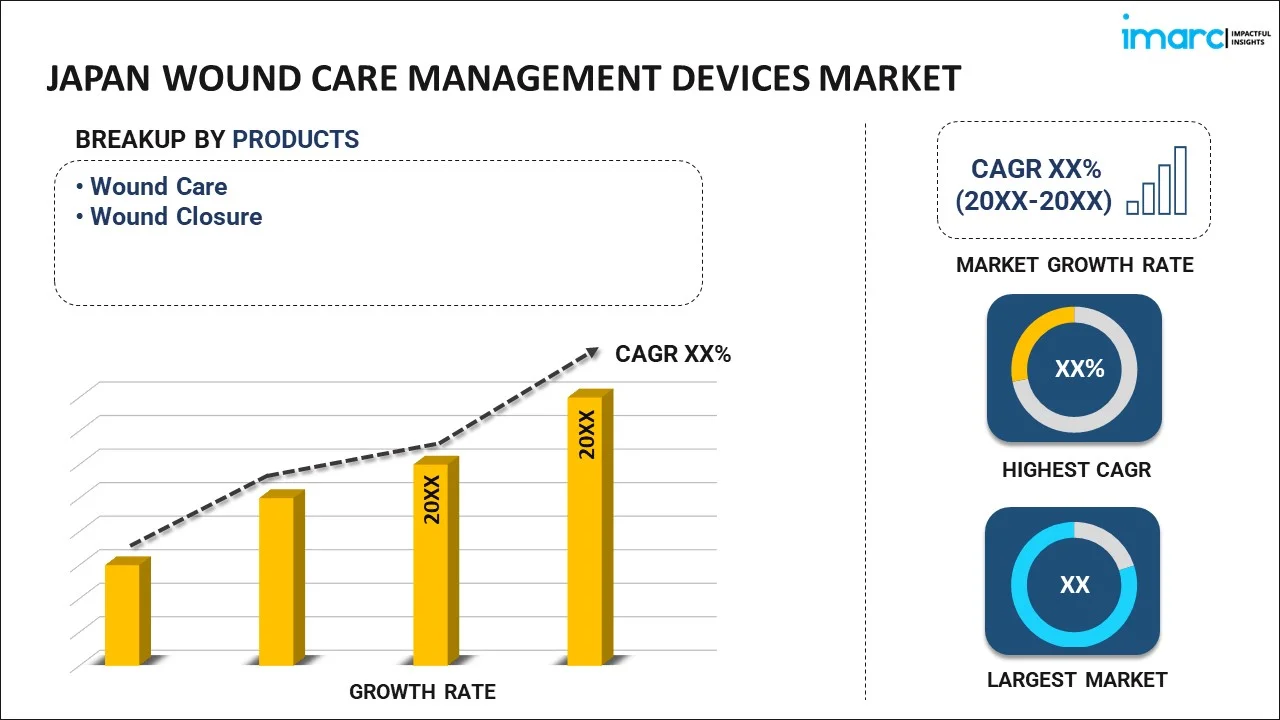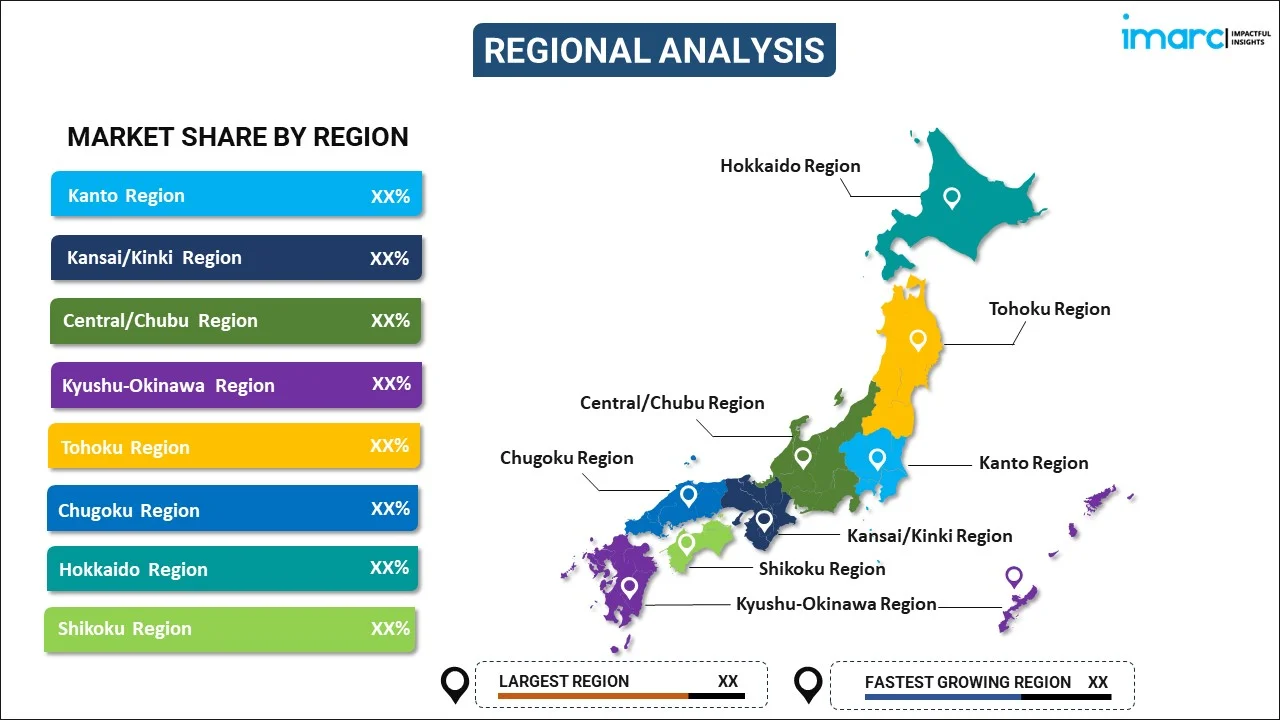
Japan Wound Care Management Devices Market Report by Product (Wound Care, Wound Closure), Wound Type (Chronic Wound, Acute Wound), and Region 2025-2033
Market Overview:
Japan wound care management devices market size reached USD 1,358.0 Million in 2024. Looking forward, IMARC Group expects the market to reach USD 2,238.0 Million by 2033, exhibiting a growth rate (CAGR) of 5.7% during 2025-2033. Demographic challenges, technological advancements, and a supportive ecosystem that prioritizes efficient and innovative patient care solutions are some of the primary factors bolstering the market growth.
|
Report Attribute
|
Key Statistics
|
|---|---|
|
Base Year
|
2024 |
|
Forecast Years
|
2025-2033
|
|
Historical Years
|
2019-2024
|
| Market Size in 2024 | USD 1,358.0 Million |
| Market Forecast in 2033 | USD 2,238.0 Million |
| Market Growth Rate (2025-2033) | 5.7% |
Wound care management devices comprise a broad spectrum of products designed to facilitate the healing process and provide relief to individuals with varying types of wounds, from minor abrasions to more complex surgical incisions or chronic ulcers. These devices, often an amalgamation of advanced materials and technology, aim to optimize the wound healing environment, mitigate the risk of infection, and enhance patient comfort. Over the years, innovations in this sector have transformed the approach to wound treatment, moving from traditional bandages and dressings to more sophisticated solutions like negative pressure wound therapy (NPWT), electromagnetic therapy devices, and bioactive wound care products. The evolution of these devices can be attributed to the growing understanding of wound physiology, an increasing number of chronic wound cases due to rising prevalence of conditions like diabetes, and the ever-present need for more efficient, cost-effective treatments in both hospital and homecare settings. As the population ages and healthcare demands grow, the importance of advanced wound care management devices continues to escalate, making them integral components in the overall healthcare landscape.
Japan Wound Care Management Devices Market Trends:
The Japan wound care management devices market is emerging as one of the prominent segments within the country's medical industry, driven by a confluence of demographic, economic, and technological factors. One of the distinct characteristics of Japan's population is its rapidly aging demographic; with one of the highest proportions of elderly individuals globally, the nation grapples with an increased prevalence of chronic diseases such as diabetes. This, in turn, has led to a surge in chronic wound occurrences, necessitating advanced wound care solutions. Responding to this demand, the market has seen a proliferation of cutting-edge technologies and products, from smart dressings embedded with biosensors to devices that harness negative pressure wound therapy (NPWT). Another trend gaining traction is the integration of the Internet of Things (IoT) in wound care, allowing for real-time monitoring and personalized patient care. Driving the market further are supportive government policies aimed at fostering innovation in medical technologies, coupled with an efficient healthcare system that prioritizes patient well-being. Moreover, collaborations between local companies and key players are projected to fuel the regional market in the coming years.
Japan Wound Care Management Devices Market Segmentation:
IMARC Group provides an analysis of the key trends in each segment of the Japan wound care management devices market, along with forecasts at the country level for 2025-2033. Our report has categorized the market based on product and wound type.
Product Insights:

- Wound Care
- Dressings
- Bandages
- Others
- Wound Closure
The report has provided a detailed breakup and analysis of the market based on the product. This includes wound care (dressings, bandages, and others) and wound closure.
Wound Type Insights:
- Chronic Wound
- Diabetic Foot Ulcer
- Pressure Ulcer
- Others
- Acute Wound
- Surgical Wounds
- Burns
- Others
A detailed breakup and analysis of the market based on the wound type have also been provided in the report. This includes chronic wound (diabetic foot ulcer, pressure ulcer, and others) and acute wound (surgical wounds, burns, and others).
Regional Insights:

- Kanto Region
- Kansai/Kinki Region
- Central/ Chubu Region
- Kyushu-Okinawa Region
- Tohoku Region
- Chugoku Region
- Hokkaido Region
- Shikoku Region
The report has also provided a comprehensive analysis of all the major regional markets, which include Kanto Region, Kansai/Kinki Region, Central/ Chubu Region, Kyushu-Okinawa Region, Tohoku Region, Chugoku Region, Hokkaido Region, and Shikoku Region.
Competitive Landscape:
The market research report has also provided a comprehensive analysis of the competitive landscape in the market. Competitive analysis such as market structure, key player positioning, top winning strategies, competitive dashboard, and company evaluation quadrant has been covered in the report. Also, detailed profiles of all major companies have been provided.
Japan Wound Care Management Devices Market Report Coverage:
| Report Features | Details |
|---|---|
| Base Year of the Analysis | 2024 |
| Historical Period | 2019-2024 |
| Forecast Period | 2025-2033 |
| Units | Million USD |
| Scope of the Report | Exploration of Historical and Forecast Trends, Industry Catalysts and Challenges, Segment-Wise Historical and Predictive Market Assessment:
|
| Products Covered |
|
| Wound Types Covered |
|
| Regions Covered | Kanto Region, Kansai/Kinki Region, Central/ Chubu Region, Kyushu-Okinawa Region, Tohoku Region, Chugoku Region, Hokkaido Region, Shikoku Region |
| Customization Scope | 10% Free Customization |
| Post-Sale Analyst Support | 10-12 Weeks |
| Delivery Format | PDF and Excel through Email (We can also provide the editable version of the report in PPT/Word format on special request) |
Key Questions Answered in This Report:
- How has the Japan wound care management devices market performed so far and how will it perform in the coming years?
- What has been the impact of COVID-19 on the Japan wound care management devices market?
- What is the breakup of the Japan wound care management devices market on the basis of product?
- What is the breakup of the Japan wound care management devices market on the basis of wound type?
- What are the various stages in the value chain of the Japan wound care management devices market?
- What are the key driving factors and challenges in the Japan wound care management devices?
- What is the structure of the Japan wound care management devices market and who are the key players?
- What is the degree of competition in the Japan wound care management devices market?
Key Benefits for Stakeholders:
- IMARC’s industry report offers a comprehensive quantitative analysis of various market segments, historical and current market trends, market forecasts, and dynamics of the Japan wound care management devices market from 2019-2033
- The research report provides the latest information on the market drivers, challenges, and opportunities in the Japan wound care management devices market.
- Porter's five forces analysis assist stakeholders in assessing the impact of new entrants, competitive rivalry, supplier power, buyer power, and the threat of substitution. It helps stakeholders to analyze the level of competition within the Japan wound care management devices industry and its attractiveness.
- Competitive landscape allows stakeholders to understand their competitive environment and provides an insight into the current positions of key players in the market.
Need more help?
- Speak to our experienced analysts for insights on the current market scenarios.
- Include additional segments and countries to customize the report as per your requirement.
- Gain an unparalleled competitive advantage in your domain by understanding how to utilize the report and positively impacting your operations and revenue.
- For further assistance, please connect with our analysts.
 Inquire Before Buying
Inquire Before Buying
 Speak to an Analyst
Speak to an Analyst
 Request Brochure
Request Brochure
 Request Customization
Request Customization




.webp)




.webp)












